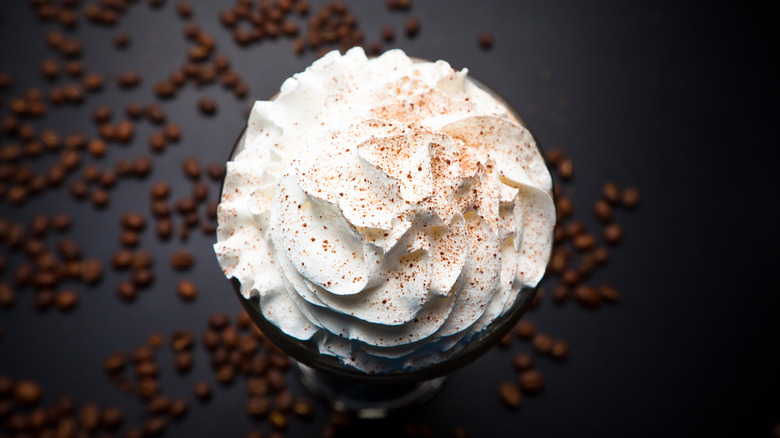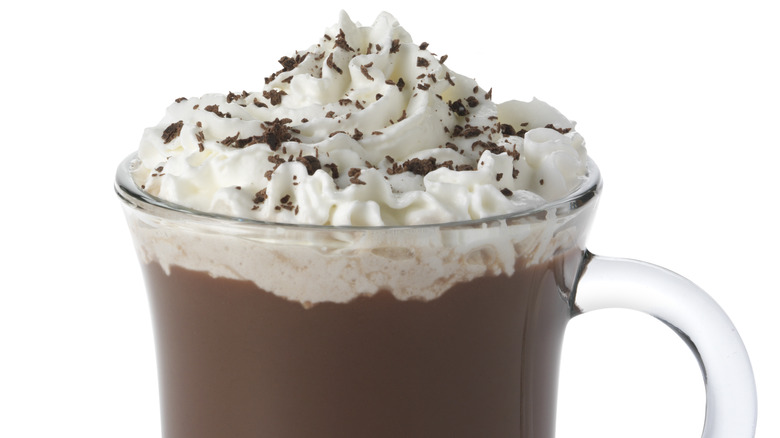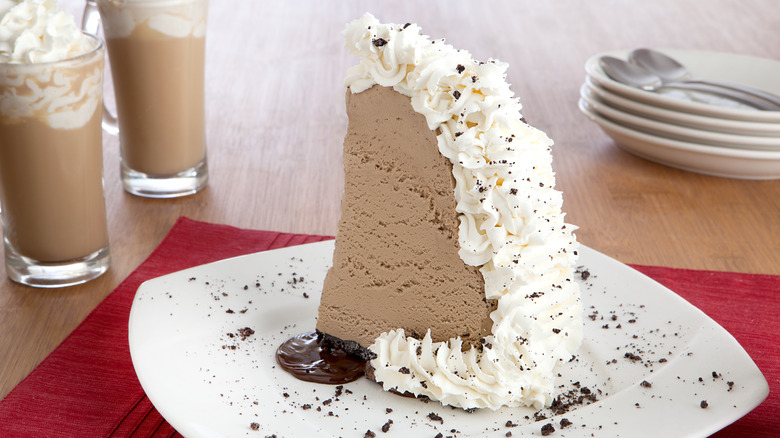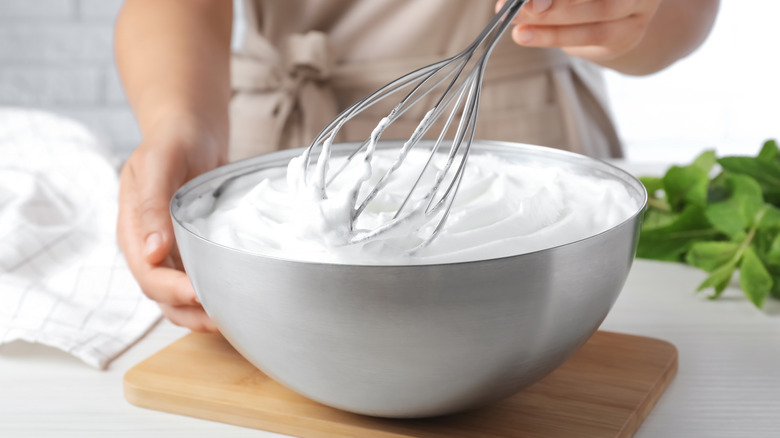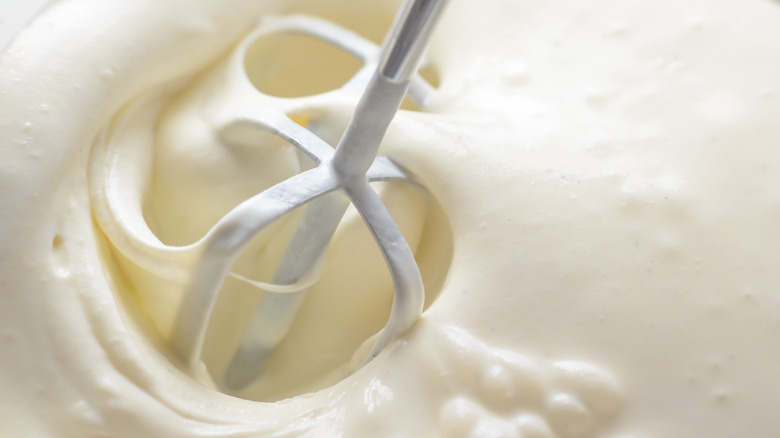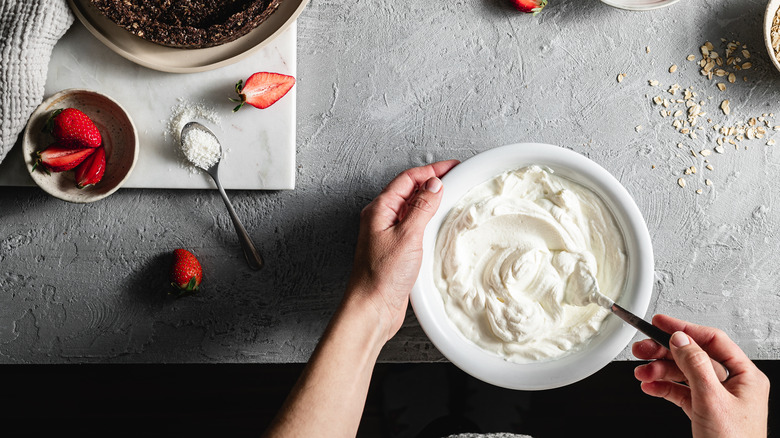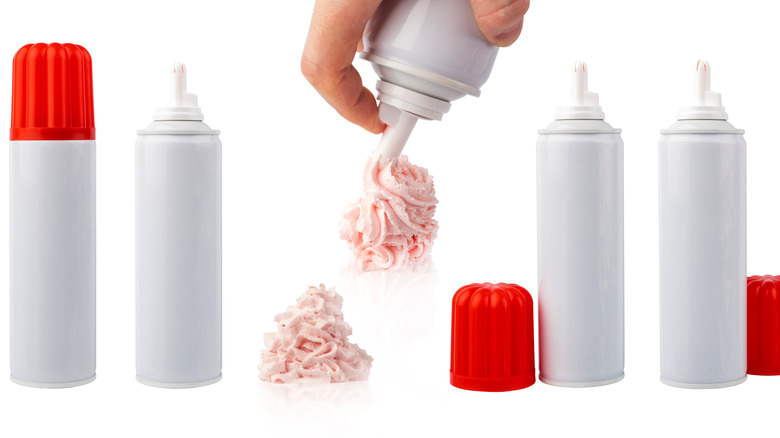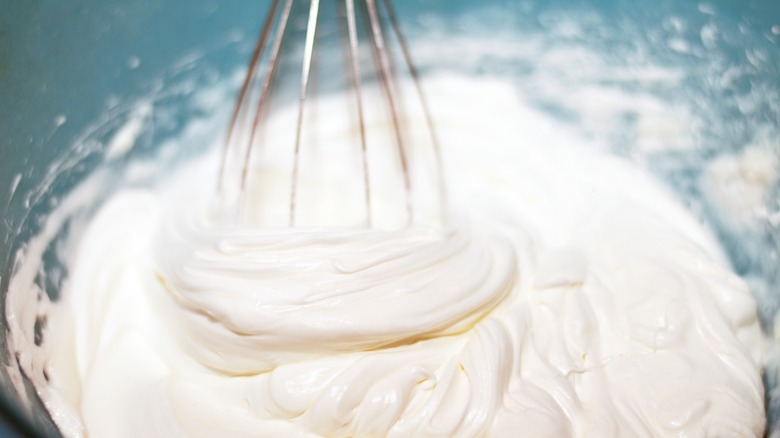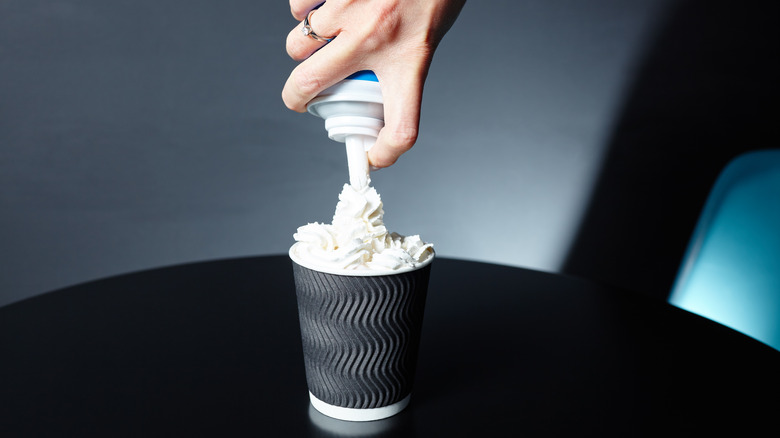The Sweet And Fluffy History Of Whipped Cream
For many sweet tooth lovers out there, whipped cream encapsulates everything great about dessert — it's sweet, pretty to look at, and oh so easy to eat. This fluffy mound of sugar brings comfort and joy — even better, whipped cream can go with just about any dessert, whether it's squirted from a can on top of a piece of pie or meticulously piped onto a high-end wedding cake.
But did you know that the origin of whipped cream has a surprisingly deep back story? Once a rare treat requiring exhausting physical labor and a careful hand to make, it later became emblematic of everything we love (and possibly hate) about American food culture – makers of whipped cream figured out how to put it into aerosol cans and make dairy-free substitutes out of everything from almonds to soy. Of course, some diehard cooks still go all old-school and pour chilled fresh cream into a bowl and have at it with a balloon whisk. However you enjoy whipped cream, we're shining a light on its origin — so you will not only appreciate whipped cream for its taste, but also for its amazing history.
The earliest versions of whipped cream contained eggs
The residents of Chantilly, France, proudly claim whipped cream as their own, asserting that it had been invented in 1671 by the butler at the town's castle when the kitchen ran short of cream for a dessert. The butler discovered that by shaking the cream vigorously, he could increase its volume and make the small quantity on hand go further — and thus whipped cream was born. And to this day, the French term for whipped cream is "crème Chantilly."
It would be a cool story if it were true. But in reality, Italian cooks had been whipping up cream for their desserts since the 1500s, when the once-scorned practice of consuming dairy (then locally done only by peasant farmers who worked with cattle) was adopted by the upper classes. And of course, being the upper classes, simply drinking milk straight from the cow wouldn't do. Instead, they (or more likely, their cooks), devised the earliest known version of whipped cream, a mousse-like concoction they called "milk snow": Like today's whipped cream, it was a fluffy mixture featuring cream, sugar, and flavoring. But unlike modern whipped cream, it also included beaten egg whites to enhance the fluffiness factor. The new treat spread from Italy to England and throughout Europe, losing the eggs and gaining a new origin story along the way.
The first whipped cream topper for ice cream appeared in 1722
Whipped cream and ice cream are a classic dessert combo. And while sensible people may question the wisdom of piling two sweet dairy products on top of each other, the mixture somehow works, especially when hot fudge, nuts, or other treats are added to the mix. If you've ever doubted how strongly whipped cream and ice cream are linked in dessert lovers' minds, try setting up a sundae bar at home and not including whipped cream — at least one disgruntled diner will be sure to remind you it's missing.
Given how ubiquitous the combo is now, it's hard to imagine a time when it wasn't around. But in the 18th century, when both ice cream and whipped cream were treats for the wealthy, it took a cook who had access to both — as well as a clientele with deep pockets — to put them together. And this cook was Sicilian-born Francesco Procopio dei Coltelli, who owned a high-end Paris restaurant called Le Procope. He counted royalty among his clients, and during a catering gig at Chantilly Castle in 1722, famously prepared ice cream topped with whipped cream for King Louis XV. And if you want a feel for what it was like to dine in Procopio's restaurant, you can — Le Procope is still operating, and is thought to be the oldest restaurant in Paris.
There's a fraternity of professional whipped cream makers in France
Most of us grew up thinking of whipped cream as a treat, an unpretentious pleasure anyone can enjoy. This is in part because you don't need any culinary skills to enjoy it: All you have to do is head to the store for a handy can or tub of your favorite brand, bring it home, and squirt or spoon away. And even those of us who take pride in making our own whipped cream from scratch generally don't put too much thought into its production — just dump some cream into a mixer, turn it on, and blend in some sugar (and maybe vanilla) when it looks fluffy enough. Easy-peasy.
But for every simple enterprise, there is always a select group of aficionados that kick it up a notch and dedicate significant time and effort into perfecting it. For connoisseurs of whipped cream, this group is the French organization La Confrerie des Chevaliers Fouetteurs de Crème Chantilly (literally, the "Brotherhood of Knights of Chantilly Cream Whippers"). And yes, they do consider themselves knights — and their mission is to perfect and perpetuate the art of making crème Chantilly (which the group considers a distinct, more refined version of whipped cream, and flavorful enough to eat as a dessert on its own.)
Non-dairy whipped topping was originally developed as a health food
Mention the phrase "non-dairy whipped topping," and your inner nutritionist will probably cringe. Sure, it's cheap and tasty, but what exactly is in it? Whatever those unpronounceable ingredients on the label are, they can't possibly be doing us any good. Of course, that won't stop us from buying or eating it, but it may not be something we're proud to do. And many of us certainly won't admit to eating it regularly. Sure, fake whipped cream is kind of tasty, and we might have grown up with it — and even have a soft spot for it — but as responsible adults, we've officially relegated whipped cream (in any form) to the occasional guilty pleasure category.
But ironically, the first non-dairy whipped topping was invented as a safer, more wholesome alternative to the fatty decadence of real whipped cream. Its inventor, Ella Eaton Kellogg, was the wife of cereal magnate and health food advocate John Harvey Kellogg, and like her husband, had an interest in wellness and advocated for a simple vegetarian diet. Her whipped cream alternative featured thinned almond butter whipped with egg whites before being sweetened. Unlike cornflakes, her husband's best-known invention, Ella's almond-based whipped topping didn't seem to have achieved mass appeal — but it set the stage for numerous more prominent whipped cream alternatives to come.
Henry Ford inspired the invention of a soy-based whipped cream substitute
Henry Ford is best known for introducing the iconic Model T and inventing the modern, large-scale production process for cars. But his penchant for invention and industrial production practices wasn't limited to cars. During the Great Depression, he became concerned about the plight of local farmers, who'd been struggling through the economic crisis. Ford threw himself into the challenge of discovering a crop that would thrive in Michigan, where he was based, and also be easily marketable. After extensive investigation, he settled upon the soybean and became a vocal champion of soy-based products, even incorporating soy additives into his car paint.
Of course, Ford didn't do all his research alone; he had a team of experts. And when World War II broke out and strict rations were placed on dairy products, one of his former team members saw an opportunity to make and sell soy-based dairy substitutes, including whipped topping. Other inventors followed suit, and soon soy-based whipped toppings — cheaper and longer-lasting than real whipped cream — became familiar items on American grocery lists.
Aerosol whipped cream was invented in a University of Illinois laboratory
Some of the world's most consequential inventions came about by accident. The antibiotic effects of penicillin were discovered when researcher Alexander Fleming saw mold growing on one of his bacteria cultures and noticed that the mold seemed to repel the bacteria. And according to legend, Champagne was invented when a 17th-century monk, Dom Pérignon, discovered that a bottle of wine he'd been aging had undergone a secondary fermentation and had, to his surprise, turned bubbly.
And in the 1930s, a University of Illinois graduate student named Charles Getz made an unexpected observation that led to another memorable invention: His research interest was food preservation, and while experimenting with carbonation and its possible applications to food preservation, he noticed that pressurizing milk with carbon dioxide made it foamy. Intrigued by his accidental creation, he tried putting the cream in pressurized cans. The resulting cream was fluffy, but bitter-tasting due to the carbon dioxide. With help from his advisor, Getz identified nitrous oxide as a workable substitute and patented the first-ever aerosol whipped cream. But it was his advisor, George Frederick Smith, who brought the new concoction to market, branding it Instantwhip. The Instantwhip company – and its eponymous whipped cream — are still around today.
Modern whipping cream lasts longer—but is harder to whip
When non-dairy whipped topping hit the market, consumers took to it eagerly. It was not only cheaper than real whipped cream, it held its shape better and lasted longer too. And when mass-market non-dairy toppings were introduced during World War II, they almost certainly offered a welcome dose of cheer to war-weary Americans living with strict dairy rations.
Even after the war ended, Americans' love affair with non-dairy toppings did not. While fresh cream was available again, making whipped cream from scratch was still considered challenging, and the resulting cream, tasty as it was, had a short shelf life. As a result, sales of whipping cream declined 30% between 1962 and 1972. The dairy industry attempted to win consumers back by offering ultra-pasteurized whipping cream reinforced with emulsifiers and stabilizers. This cream had the advantage of a longer shelf life — however, it was even more difficult to whip into fluff than regular heavy cream.
Cool Whip was created by the inventor of Pop Rocks
The boom years following World War II were a time of innovation in the United States, with consumers eagerly embracing new developments ranging from television to the modern suburban subdivisions. It was also an era of innovation in the commercial whipped cream space — there seemed to be a bottomless public appetite for the stuff, and inventors were there to meet it. Among the well-known brands that made their debut during these years were Reddi-Wip, Dream Whip, Presto Whip, and Cool Whip. While they varied in form — Reddi-Wip came in a can, Dream Whip was a powder to be reconstituted with water, and Cool Whip came frozen — all offered fluffy sweetness and convenience.
Cool Whip in particular was poised for success from the start. It was designed to be a direct competitor to Reddi-Wip, and its presentation — sold in tubs in the freezer section — immediately set it apart. And its creator, William A. Mitchell, a food scientist with General Foods' Birds Eye division, proved to have an uncanny talent for launching popular processed foods. Cool Whip became Birds Eye's top-grossing product within two years of its launch, and Mitchell went on to invent such iconic products as Pop Rocks and Tang.
Old recipes called for whipping cream with a branch
Be grateful you're not one of the early cooks first making whipped cream: Pre-19th century recipes called for beating it with a willow twig. As you can probably imagine, this process (romantic as it may have been) was beyond inefficient, and required more than an hour of arm-numbing labor.
Today, making whipped cream is pretty simple for an experienced cook. With an electric mixer, it takes just a few mostly hands-off minutes. Your main job as cook is to keep an eye on it to ensure you don't whip the cream too long and accidentally turn it into butter. If you only need a small amount of whipped cream (say, enough for dessert for two), it's almost as fast to whip it up by hand with a balloon whisk – the whisks are designed to aerate the foods they beat, helping them get fluffier faster. Your arm may get a bit sore from the effort, but your whipped cream should come together quickly.
And while you're hand-beating your whipped cream, use Gordon Ramsay's trick of whipping with one arm for a short time, then the other, to keep from getting sore!
A whipped-cream-covered model on an album cover sparked a scandal
"Whipped Cream and Other Delights" sounds like the title of a wholesome 1950s cookbook, the sort you'd expect to see in your grandmother's kitchen. But it's actually the name of a chart-topping jazz album from the mid-1960s by Herb Alpert and the Tijuana Brass. And while it was one of the best-selling albums of the decade, much of its fame (or notoriety) came not from its music, but from its cover, which featured a young woman who appeared to be clad in nothing but thick puffs of whipped cream.
Scandalous for its time, the cover design eventually drew more attention than the album itself, becoming such a prominent cultural artifact it earned a place in the Smithsonian. And while the music from the album has now been mostly forgotten, the idea of using whipped cream as a seductive garment lives on in the public imagination – pasties shaped like whipped cream rosettes can easily be found online.
Reddi-Wip was originally delivered by milkmen
Through much of the 20th century, many Americans didn't go to the store to buy milk, but had it brought to them — white-clad milkmen and their refrigerated trucks were a common sight in residential neighborhoods, as was the appearance of a cold glass bottle of milk (or two) by one's front door in the early morning hours. It was not only easy and convenient for consumers, but in the pre-pasteurization days of milk delivery — when home refrigerators were unreliable or non-existent — it was the best way to ensure they always had fresh milk. And even later, it proved a good way for busy families to ensure they never ran out.
In the late 1940s, St. Louis inventor and entrepreneur Aaron "Bunny" Lapin devised a way to package whipped cream into a spray can, boasting (per St. Louis Magazine) that his invention heralded "the beginning of pressure-propelled packaging." In 1948, his whipped cream invention, which he dubbed Reddi-Wip, was introduced to St. Louis consumers by milkmen, who left it at customers' front doors with the milk bottles. Customers were not only delighted to have fresh whipped cream waiting at their door, but by the fun and convenience of squirting it out. Reddi-Wip took off, earning $7 million in annual sales by 1951.

